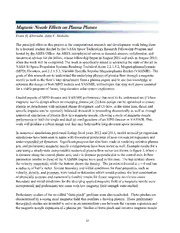
NASA Technical Reports Server (NTRS) 20150003800: Magnetic Nozzle Effects on Plasma Plumes PDF
Preview NASA Technical Reports Server (NTRS) 20150003800: Magnetic Nozzle Effects on Plasma Plumes
Magnetic Nozzle Effects on Plasma Plumes Frans H. Ebersohn, John V. Shebalin The principal effort in this project is the computational research and development work being done by a doctoral student funded by the NASA Space Technology Research Fellowship Program and hosted by the ARES Office. An ARES astrophysicist serves as research mentor, collaborator, and theoretical advisor for the fellow, whose fellowship began in August 2011 and ends in August 2015, when the work will be completed. The work is specifically aimed at advancing the state of the art in NASA In-Space Propulsion Systems Roadmap Technical Areas 2.2.1.3.2, Magnetoplasmadynamic (MPD) Thrusters, and 2.2.1.3.3, Variable Specific Impulse Magnetoplasma Rocket (VASIMR). The goals of this research are to understand the underlying physics of plasma flow through a magnetic nozzle as well as the flow’s later detachment from a plasma engine and to use this knowledge to optimize the design of both MPD rockets and VASIMR, technologies that may well prove essential for a viable program of future, long-duration solar system exploration. Crucial aspects of MPD thruster and VASIMR performance that need to be understood are (1) how magnetic nozzle design affects an emerging plasma jet; (2) how design can be optimized to ensure plasma jet detachment with minimal plume divergence; and (3) how, at the same time, thrust and specific impulse can be optimally balanced. Research is proceeding theoretically as well as through numerical simulation of plasma flow in a magnetic nozzle, allowing a study of magnetic nozzle performance in both the single and dual jet configurations of an MPD thruster or VASIMR. This work will produce a robust design tool that may help enable long-duration space missions. In numerical simulations performed during fiscal years 2012 and 2013, model inviscid jet expansion simulations have been seen to agree with theoretical predictions of near-vacuum jet expansion and under-expanded jet dynamics. Significant progress has also been made in modeling resistive plasma jets, and preliminary magnetic nozzle configurations have been tested as well. Example results for a case using a steady-state axisymmetric numerical plasma flow solver are shown in figure 1, where x is distance along the central plume axis, and r is distance perpendicular to the central axis. Inflow parameters similar to those of the VASIMR engine were used in this case. The top contour shows the velocity magnitude, while the bottom shows the density. The jet inlet is located at x = 0 and has a radius r of half a meter. Several boundary and initial conditions for fluid properties, such as o velocity, density, and pressure, were tested to determine which would produce the best combination of physically accurate and numerically feasible results for future magnetic nozzle test cases. Boundary and initial conditions for the diverging applied magnetic field of a magnetic nozzle were incorporated, and preliminary test cases with low magnetic field strength were studied. Preliminary studies of the so-called “theta-pinch” problem were also conducted. Theta-pinches are characterized by a strong axial magnetic field that confines a flowing plasma. These preliminary theta-pinch studies are intended to serve as an intermediate case between the vacuum expansion and the magnetic nozzle expansion of a plasma jet. Studies of theta-pinch and resistive magnetic nozzle 22 plasma jet expansions will continue, and results will be compared to experiments, which will guide the evolution of the computational method. The effect of the Hall and electron pressure terms in the generalized Ohm’s law will also be studied, and these terms will be incorporated as necessary in the computer program. Furthermore, the need for subgrid scale magnetohydrodynamic turbulence models will be evaluated. Periodic assessments of numerical robustness are, of course, an ongoing activity. Figure 1.– (a) Velocity and (b) density contours for jet expansion with parameters near the regimes of VASIMR. No magnetic field is applied. 23
